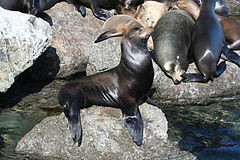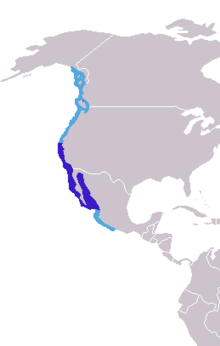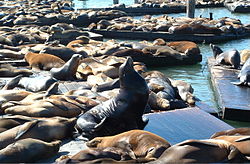California sea lion
(Redirected from California Sea Lion)
| California sea lion | |
|---|---|
 |
|
| Conservation status | |
Least Concern (IUCN 3.1)[1] |
|
| Scientific classification | |
| Kingdom: | Animalia |
| Phylum: | Chordata |
| Class: | Mammalia |
| Order: | Carnivora |
| Suborder: | Pinnipedia |
| Family: | Otariidae |
| Subfamily: | Otariinae |
| Genus: | Zalophus Gill, 1866 |
| Species: | Z. californianus |
| Binomial name | |
| Zalophus californianus (Lesson, 1828) |
|
 |
|
| California sea lion breeding range in dark blue, total range light blue | |
Contents
|
Description


Ecology
Range and populations
As its name suggests, the California sea lion is found mainly around the waters of California. However, they can also be found from the Alaska Panhandle in the north to Mexico in the south. The Galápagos sea lion and the extinct Japanese sea lion were once considered subspecies of the Californian sea lion. Now, these two populations are generally considered as distinct species.
Habitat
California sea lions prefer to breed on sandy beaches. They usually stay no more than 10 miles out to sea. On warm days, they stay close to the water's edge. At night or on cool days, the sea lions will move inland or up coastal slopes. Outside of the breeding season, they will often gather at marinas and wharves, and may even be seen on navigational buoys. Sea lions living around islands are less vulnerable to predation than coastal ones. The sea lion's major predators are killer whales and white shorks.California sea lions can also live in fresh water for periods of time. They feed on Pacific in front of Bonneville Dam, 146.1 river miles from the Pacific Ocean. Historically, sea lions hunted salmon in the Columbia River as far as The Dalles and Celilo Falls, 200 miles (320 km) from the sea, as remarked upon by people such as George Simpson in 1841[citation needed]. In 2004, a healthy sea lion was found sitting on a road in Merced County, California, almost a hundred miles upstream from San Francisco Bay and half a mile from the San Joaquin River.
Diet

California sea lions may eat alone or in small to large groups, depending on the amount of food available. They will cooperate with other predators (dolphins, porpoises, and seabirds) when hunting large schools of fish.Sea lions from the Washington will wait at the mouths of rivers for the salmon run. They also have learned to feed on steelhead and white sturgeon below fish ladders at Bonneville Dam and at other locations in the Columbia River, Willamette River, and in Puget Sound.Adult females forage between 10 and 3000 km from the rookery, and dive to average depths of 31.1 to 98.2 m, with maximum dives between 196 and 274 m. They travel at an estimated speed of 10.8 km/h, and young sea lions have an initial defecation time averaging 4.2 hours. Adult females spend 1.6-1.9 days on land and 1.7-4.7 days at sea.
Behavior
Reproduction
California sea lions are highly social, and breed from May to June. When establishing a territory, the males will try to increase their chances of breeding by staying on the rookery for as long as possible. During this time, they will fast, using their blubber as an energy store. Size is a key factor in winning fights as well as waiting. The bigger the male, the more blubber he can store, and the longer he can wait.Before mating begins, females may form "milling" groups of two to 20 individuals. The females in these groups will mount each other and even the territorial male. Eventually, one or two of the females will mate and the milling stops.The territorial and mating system of the California sea lion has been described as similar to a system. The females choose their mates rather than the territories where the males are.A male sea lion can hold his territory for only up to 29 days.Females do not become receptive until 21 days after the pups are born, thus the males do not set up their territories until after the females give birth.Most fights occur during this time. Soon, the fights go from violent to ritualized displays, such as vocalizations, head-shaking, stares, and bluff lunges. There can be as many as 16 females for one male. For adult males, territorial claims occur both on land and underwater. They have even been known to charge divers who enter their underwater territory.
The females have a 12-month reproductive cycle, 9-month actual gestation with a 3-month delayed implantation of the fertilized egg after giving birth in early to mid-June. Mothers may give birth on land or in water. The pups are born with their eyes open and can vocalize with their mothers. Pups may nurse for up to six months, and grow rapidly due to the high fat content in the milk. California sea lions, along with other otariids and walruses, are possibly the only mammals whose milk does not contain lactose. At about two months, the pups learn to swim and hunt with their mothers.
Communication
California sea lions are well known for their dog-like barks. They are very vocal, particularly during the breeding season. Adult males make deep, loud barks repeatedly when establishing territories. After that, the males are mostly quiet unless their territorial boundaries have been violated by a rival. Barking may also attract mates. Female sea lions emit a unique vocalization when calling their pups, and the pups themselves will bleat and make a high pitched alarm call. Juveniles and subadults of both sexes will make high-pitched barks when alarmed.Non-breeding activities
After the breeding season, females normally stay in the breeding areas or migrate further south, while the adult males and juveniles generally migrate north for the winter. Social organization during the nonbreeding season is unstable. However, a size-related dominance hierarchy does exist.Large males use vocalization and movement to show their dominance, and smaller males always yield to them. Nonbreeding groups are gregarious on land and often squeeze together. Most sea lions found in man-made environments are males or juveniles, because sea lions do not breed there and those groups are more likely to migrate to those places during the nonbreeding season.Interactions with humans

IN ENTERTAINMENT
The California sea lion is used in military applications by the U.S. Navy Marine Mammal Program, including detecting underwater landmines and equipment recovery. Sea lions can be highly useful as they can reach places inaccessible to human divers. They can dive to 1,000 feet (304.8 m) and swim silently and up to 25 miles per hour (40 km/h) in short bursts.
Sea lions have been sent in the Persian Gulf to protect U.S. ships from enemy divers.The animals are trained to swim behind divers approaching a ship, and attach a clamp, which is connected to a rope, to the diver's leg. Navy officials say the sea lions can get the job done in seconds, and the enemy does not know the clamp was attached to his leg until it is too late.
Status
In 2007, legislation amending the MMPA to permit their lethal removal from near salmon runs when their population exceeds their maximum sustainable level was introduced (HR 1769: Endangered Salmon Predation Prevention Act). The purpose of HR 1769 is to relieve pressure on the crashing Pacific Northwest salmon populations. Officially, pinnipeds (including sea lions) account for only an estimated 4 of salmon loss in 2007. However, that figure comes from actual surface observation. Much predation occurs underwater, leading marine biologists to conclude the true rate is higher.
Short of lethal removal, attempts have been made to identify individual aggressive salmon predators, and to relocate them. Relocation generally fails because they simply return. In January 2008, at the request of Washington and Oregon, the National Marine Fisheries Service drafted a proposal to euthanize approximately 30 animals annually at Bonneville Dam. The Humane Society threatened a lawsuit. In response, the 9th U.S. Circuit Court of Appeals directed that the animals be removed, but not killed.
From the Humane Society court case—NMFS's decision to authorize the killing of these animals is impossible to reconcile with: (1) NMFS's 2005 decision finding that fishermen's annual take of up to 17 percent of listed salmon is not significant and has only 'minimal adverse effects on Listed Salmonid ESUs in the Columbia River Basin;' (2) the States' 2008 decision to increase fishing quotas from 9 percent to 12 percent of the total spring run; and (3) NMFS's 2007 decision finding that hydroelectric dam take up to 60 percent of listed juvenile salmonids and up to 17 percent of listed adult salmonids 'meet[s] or exceed[s] the objectives of doing no harm and contributing to recovery with respect to the ESUs.'"
In 2009, strandings of recently-weaned pups increased three-fold. Lesser winds reduced ocean upwelling, which in return reduced food supplies. Worse, poisonous domoic acid from algal blooms got into the sea lions' food chain. Nearly 3/4 of that June's 341 stranded pups died. Strandings were only a small part of a much larger problem. The National Marine fisheries Service estimated the 2009 pup mortality rates were twice as high as those in 2008, again at 3/4 of the estimated 59,000 newborns.
-
 Underwater view of sea lion swimming
Underwater view of sea lion swimming -
California sea lions at the wharf in Santa Cruz, California
-
 California sea lion at Queens Zoo, New York
California sea lion at Queens Zoo, New York -
 California sea lion at Zoom Gelsenkirchen, Germany
California sea lion at Zoom Gelsenkirchen, Germany






No comments:
Post a Comment